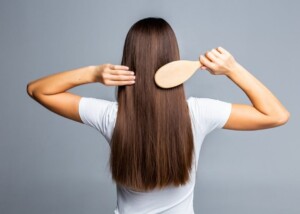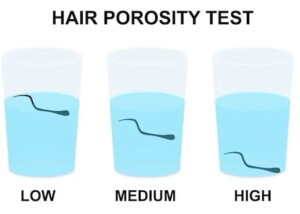Yes, it is real! Hair porosity really does exist and if you are wondering what it is, you have come to the right place. In this article you will find what is hair porosity, how to determine the porosity of your hair, as well as how to take care of differently porous hair. All this information will help you to create an optimal hair care routine and have a good hair day every day.
What is hair porosity?

Source: Freepik.com
Porosity measures how well hair can take in and retain moisture, indicating the ease with which moisture penetrates the hair. While hair porosity is primarily influenced by genetics, it can also be affected by external factors like heat and chemical treatments. Porosity can be seen in other material as well, including wood, sponge, rock, and of course your face. When discussing hair, the porosity level is based on the structure of the hair cuticle, which is the outermost layer of each hair strand.
Types of porosity
We can differentiate between three main types: Low porosity, Normal/Medium porosity, and High porosity.
Low porosity hair:
This type of hair is not very porous which means that it is difficult for moisture to get through the hair strand. Hair cuticles are placed very tightly together and therefore, your hair might need a little help with conditioning. Low porosity hair usually takes longer time to dry after washing, it may be easier for it to create a product build-up, and it may be resistant to hair dyes or other chemical styling.
Normal/Medium porosity hair:
Just as the name suggests, this type of hair has medium moisture absorption and retention thanks to a looser cuticle layer. It usually handles well hair styling, hair dyes, and different types of hair treatments.
High porosity hair:
Highly porous hair has bigger gaps and opening in the cuticle layer which allows the hair to easily absorb moisture but also to lose it quickly. High porosity mainly happens due to damage from straighteners, curlers, hair dyes and hair styling. This type of hair usually dries faster after washing but it is prone to be frizzy and tangle in humid weather.

Source: Freepik.com
How to find out the porosity of your hair?
To find out the porosity level of your hair, there are few easy tests that you can do at home. These do not guarantee an exact result. However, the outcome may help you guess your hair type. The most famous test requires only three things: a glass, water, and your hair. To complete the float test correctly, follow these steps:
- Make sure your hair is clean and free of any products.
- Fill up a glass with water.
- Take few strands of your hair (preferably ones that you lost naturally).
- Drop them into the water and let them sit for a moment.
If after few minutes the strand float on the top, you most likely have low porosity hair. If they sink to the bottom, your hair is probably highly porous. And lastly, if the strands stay somewhere in the middle of the glass, this indicates normal/medium porosity.

Source: Freepik.com
How to take care of hair with different porosity?
Simply put, knowing the porosity of your hair will help you determine what to put on your hair to achieve the best possible look and feel. Porosity is significant because it allows you to choose products that will either help you restore moisture to your hair or address dryness and breakage problems. Here are some tips on how to take care of hair with different porosity.
Low porosity hair care:
- Use a pre-washing serum to remove build-up.
- Include oils in your routine (avocado oil, grape seed oil or shea butter).
- Do a deep conditioning treatment every two weeks.
Medium porosity hair care:
- Include hair bonding products in your routine.
- Deep condition once in a while.
- Use leave-in conditioner.
- Do not over wash your hair.
High porosity hair care:
- Use highly moisturizing products with protein included.
- Deep condition weekly.
- Include leave-in conditioner to keep the hair hydrated.
- Use anti-frizz products.
- When washing, try to use colder water.

Source: Freepik.com
Remember that hair porosity and ways to test it exist only to give you an idea about what is your hair type. If you find yourself to be concerned about the state and health of your hair, be sure to consult with a professional. By identifying whether your hair is low, medium, or high porosity, you can select the right products and techniques for a perfectly tailored hair care routine.
The article was written by Lea Kovalská.




